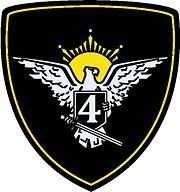Viru Infantry Battalion
| Viru Infantry Battalion Viru jalaväepataljon | |
|---|---|
|
Viru Infantry Battalion | |
| Active |
1917–1918 1918–1940 1992–present |
| Country |
|
| Branch |
|
| Type |
Infantry Anti-tank warfare |
| Size | Battalion |
| Part of | 1st Infantry Brigade |
| Garrison/HQ | Jõhvi |
| Motto | Eesti kodu kaitseks |
| Anniversaries |
Formed: 6 December 1917 Restored: 22 May 1992 |
| Engagements | Estonian War of Independence |
| Commanders | |
| Current commander |
Lieutenant Colonel Eero Kinnunen |
| Notable commanders |
Aleksander Seimann Jakob Vende |
The Viru Infantry Battalion (Estonian: Viru jalaväepataljon) is a battalion of the Estonian Land Forces. It is a part of the 1st Infantry Brigade and its primary task is to train conscription-based infantry and anti-tank units. The battalion has been previously known as the 4th Infantry Regiment and as the 4th Single Infantry Battalion. The battalion is currently based at Jõhvi and is commanded by Lieutenant Colonel Eero Kinnunen.
History
Formation
4th Infantry Regiment (Estonian: 4. eesti polk) was formed on 6 December 1917 and its subunits were scattered across Northern Estonia. Following the occupation of Estonia by the German Empire the 4th Infantry Regiment was disbanded on 5 April 1918. The unit was re-established in Narva after the German occupation ended.
Estonian War of Independence
In the beginning the Estonian War of Independence the regiment had just 595 men in 2 battalions. On 28 November 1918 the positions of the 4th Infantry Regiment were attacked by the 6th Division of the Red Army. Together with few hundred Narva and Virumaa Estonian Defence League members the regiment was forced to leave Narva and retreat west. On 4 January 1919 units of 4th Infantry Regiment helped to stop the advancing Red Army at Valkla. During the following counter-offensive the regiment participated in liberating Narva on 19 January 1919. By the end of the war the unit had 53 officers and 1476 NCOs and soldiers in its ranks.[1]
1920–1940
After demobilization the unit was renamed 4th Single Infantry Battalion and was based at Narva-Jõesuu. On 1 April 1924 the battalion was added to the 5th Infantry Regiment at Narva. On 1 October 1928 most units of 4th Single Infantry Battalion were moved to Jõhvi and Kurtna training area, one infantry and one machine gun platoon took positions at Vasknarva. After the Soviet occupation in 1940 the battalion was disbanded.[2]
1992–present
The unit was restored as Viru Infantry Battalion on 22 May 1992 in Jõhvi. The battalion participates in training conscripts for infantry and anti-tank units.[1] The battalion is currently equipped with MILAN 2 and MAPATS anti-tank missiles. In the future unit will be re-equipped with FGM-148 Javelin.[3]
Current structure
Structure as of 9 January 2014:[4]
- Battalion Staff Headquarters
- 1st Training Company
- 2nd Training Company
- 3rd Training Company
- Staff and Combat Support Company
List of commanders
| Career | Commander |
|---|---|
| 1917–1918 | Hendrik Vahtramäe |
| 1918–1919 | Aleksander Seimann |
| 1919–1928 | Jakob Vende |
| 1928–1934 | Voldemar Koch |
| 1934–1940 | August Tomander |
| 1992–1993 | Peeter Prans |
| 1993–1996 | Indrek Sirel |
| 1996–2004 | Jüri Järveläinen |
| 2004–2006 | Neeme Kaarna |
| 2006–2010 | Urmet Reimann |
| 2010–2012 | Janno Märk |
| 2013–present | Eero Kinnunen |
See also
| ||||||||||||||||||||||||||||||||||||||||||||||||||||||||||||||||||||||||||||||||||||||||||||||||||||||||||||||||||||||||||||||||||||||||||||||||||
| ||||||||||
References
- ↑ 1.0 1.1 "Viru jalaväepataljon" (in Estonian). Estonian Defence Forces.
- ↑ Õun, Mati. 2001. Eesti sõjavägi 1920-40. Tallinn: Tammiskilp, page 23
- ↑ "Kaitsevägi alustas suurkolimisega" (in Estonian). Postimees.
- ↑ "Viru jalaväepataljoni põhimäärus" (in Estonian). Riigi Teataja.
